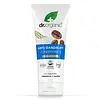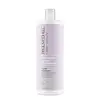What's inside
What's inside
 Key Ingredients
Key Ingredients

 Benefits
Benefits

 Concerns
Concerns

 Ingredients Side-by-side
Ingredients Side-by-side

Water
Skin ConditioningAloe Barbadensis Leaf Juice Powder
Skin ConditioningCetearyl Alcohol
EmollientGlyceryl Stearate
EmollientBrassicamidopropyl Dimethylamine
Skin ConditioningOlea Europaea Fruit Oil
MaskingCoffea Canephora Seed Extract
EmollientPiroctone Olamine
PreservativeZinc PCA
HumectantCaffeine
Skin ConditioningPaullinia Cupana Seed Extract
Skin ConditioningPiper Nigrum Fruit Extract
PerfumingUrtica Dioica Leaf Extract
Skin ConditioningZingiber Officinale Root Extract
MaskingTocopherol
AntioxidantSalicylic Acid
MaskingGlycerin
HumectantNiacinamide
SmoothingPanthenol
Skin ConditioningSalix Alba Bark Extract
AstringentAspartic Acid
MaskingParfum
MaskingMentha Arvensis Herb Oil
PerfumingLauryl Alcohol
EmollientSorbic Acid
PreservativeDicaprylyl Carbonate
EmollientDicaprylyl Ether
EmollientCitric Acid
BufferingBenzyl Alcohol
PerfumingPotassium Sorbate
PreservativeSodium Benzoate
MaskingLimonene
PerfumingLinalool
PerfumingWater, Aloe Barbadensis Leaf Juice Powder, Cetearyl Alcohol, Glyceryl Stearate, Brassicamidopropyl Dimethylamine, Olea Europaea Fruit Oil, Coffea Canephora Seed Extract, Piroctone Olamine, Zinc PCA, Caffeine, Paullinia Cupana Seed Extract, Piper Nigrum Fruit Extract, Urtica Dioica Leaf Extract, Zingiber Officinale Root Extract, Tocopherol, Salicylic Acid, Glycerin, Niacinamide, Panthenol, Salix Alba Bark Extract, Aspartic Acid, Parfum, Mentha Arvensis Herb Oil, Lauryl Alcohol, Sorbic Acid, Dicaprylyl Carbonate, Dicaprylyl Ether, Citric Acid, Benzyl Alcohol, Potassium Sorbate, Sodium Benzoate, Limonene, Linalool
Water
Skin ConditioningSodium C14-16 Olefin Sulfonate
CleansingSodium Cocoamphoacetate
CleansingLaureth-5 Carboxylic Acid
CleansingEthoxydiglycol
HumectantPEG-18 Glyceryl Oleate/Cocoate
EmulsifyingPEG-40 Hydrogenated Castor Oil
EmulsifyingVerbascum Densiflorum Flower/Stem Extract
Skin ConditioningHelichrysum Italicum Extract
AntiseborrhoeicCota Tinctoria Flower/Leaf/Stem Extract
Skin ConditioningLinum Usitatissimum Seed Extract
PerfumingOlea Europaea Oil Unsaponifiables
Skin ConditioningSelaginella Lepidophylla Extract
EmollientAmaranthus Caudatus Seed Extract
Skin ConditioningLeuconostoc/Radish Root Ferment Filtrate
AntimicrobialHypnea Musciformis Extract
Skin ProtectingHydrolyzed Pea Protein
EmollientAllantoin
Skin ConditioningLysine Hcl
Skin ConditioningZinc PCA
HumectantProline
Skin ConditioningShikimic Acid
Skin ConditioningSucrose
HumectantCaprylyl Glycol
EmollientAmodimethicone
Glycerin
HumectantPolyquaternium-10
PEG-120 Methyl Glucose Dioleate
EmulsifyingCitric Acid
BufferingC11-15 Pareth-7
EmulsifyingLaureth-9
EmulsifyingPolyquaternium-80
CleansingTrideceth-12
EmulsifyingButylene Glycol
HumectantDisodium EDTA
Trideceth-8
EmulsifyingPotassium Gluconate
Skin ProtectingPhenoxyethanol
PreservativePhenethyl Alcohol
MaskingPotassium Sorbate
PreservativeSodium Gluceptate
Sodium Benzoate
MaskingSalicylic Acid
MaskingParfum
MaskingBenzyl Alcohol
PerfumingWater, Sodium C14-16 Olefin Sulfonate, Sodium Cocoamphoacetate, Laureth-5 Carboxylic Acid, Ethoxydiglycol, PEG-18 Glyceryl Oleate/Cocoate, PEG-40 Hydrogenated Castor Oil, Verbascum Densiflorum Flower/Stem Extract, Helichrysum Italicum Extract, Cota Tinctoria Flower/Leaf/Stem Extract, Linum Usitatissimum Seed Extract, Olea Europaea Oil Unsaponifiables, Selaginella Lepidophylla Extract, Amaranthus Caudatus Seed Extract, Leuconostoc/Radish Root Ferment Filtrate, Hypnea Musciformis Extract, Hydrolyzed Pea Protein, Allantoin, Lysine Hcl, Zinc PCA, Proline, Shikimic Acid, Sucrose, Caprylyl Glycol, Amodimethicone, Glycerin, Polyquaternium-10, PEG-120 Methyl Glucose Dioleate, Citric Acid, C11-15 Pareth-7, Laureth-9, Polyquaternium-80, Trideceth-12, Butylene Glycol, Disodium EDTA, Trideceth-8, Potassium Gluconate, Phenoxyethanol, Phenethyl Alcohol, Potassium Sorbate, Sodium Gluceptate, Sodium Benzoate, Salicylic Acid, Parfum, Benzyl Alcohol
Ingredients Explained
These ingredients are found in both products.
Ingredients higher up in an ingredient list are typically present in a larger amount.
Benzyl Alcohol is most commonly used as a preservative. It also has a subtle, sweet smell. Small amounts of Benzyl Alcohol is not irritating and safe to use in skincare products. Most Benzyl Alcohol is derived from fruits such as apricots.
Benzyl Alcohol has both antibacterial and antioxidant properties. These properties help lengthen the shelf life of products. Benzyl Alcohol is a solvent and helps dissolve other ingredients. It can also improve the texture and spreadability.
Alcohol comes in many different forms. Different types of alcohol will have different effects on skin. This ingredient is an astringent alcohol.
Using high concentrations of these alcohols are drying on the skin. They may strip away your skin's natural oils and even damage your skin barrier. Astringent alcohols may also irritate skin.
Other types of astringent alcohols include:
According to the National Rosacea Society based in the US, you should be mindful of products with these alcohols in the top half of ingredients.
Any type of sanitizing product will have high amounts of alcohol to help kill bacteria and viruses.
Learn more about Benzyl AlcoholCitric Acid is an alpha hydroxy acid (AHA) naturally found in citrus fruits like oranges, lemons, and limes.
Like other AHAs, citric acid can exfoliate skin by breaking down the bonds that hold dead skin cells together. This helps reveal smoother and brighter skin underneath.
However, this exfoliating effect only happens at high concentrations (20%) which can be hard to find in cosmetic products.
Due to this, citric acid is usually included in small amounts as a pH adjuster. This helps keep products slightly more acidic and compatible with skin's natural pH.
In skincare formulas, citric acid can:
While it can provide some skin benefits, research shows lactic acid and glycolic acid are generally more effective and less irritating exfoliants.
Most citric acid used in skincare today is made by fermenting sugars (usually from molasses). This synthetic version is identical to the natural citrus form but easier to stabilize and use in formulations.
Read more about some other popular AHA's here:
Learn more about Citric AcidGlycerin is already naturally found in your skin. It helps moisturize and protect your skin.
A study from 2016 found glycerin to be more effective as a humectant than AHAs and hyaluronic acid.
As a humectant, it helps the skin stay hydrated by pulling moisture to your skin. The low molecular weight of glycerin allows it to pull moisture into the deeper layers of your skin.
Hydrated skin improves your skin barrier; Your skin barrier helps protect against irritants and bacteria.
Glycerin has also been found to have antimicrobial and antiviral properties. Due to these properties, glycerin is often used in wound and burn treatments.
In cosmetics, glycerin is usually derived from plants such as soybean or palm. However, it can also be sourced from animals, such as tallow or animal fat.
This ingredient is organic, colorless, odorless, and non-toxic.
Glycerin is the name for this ingredient in American English. British English uses Glycerol/Glycerine.
Learn more about GlycerinParfum is a catch-all term for an ingredient or more that is used to give a scent to products.
Also called "fragrance", this ingredient can be a blend of hundreds of chemicals or plant oils. This means every product with "fragrance" or "parfum" in the ingredients list is a different mixture.
For instance, Habanolide is a proprietary trade name for a specific aroma chemical. When used as a fragrance ingredient in cosmetics, most aroma chemicals fall under the broad labeling category of “FRAGRANCE” or “PARFUM” according to EU and US regulations.
The term 'parfum' or 'fragrance' is not regulated in many countries. In many cases, it is up to the brand to define this term.
For instance, many brands choose to label themselves as "fragrance-free" because they are not using synthetic fragrances. However, their products may still contain ingredients such as essential oils that are considered a fragrance by INCI standards.
One example is Calendula flower extract. Calendula is an essential oil that still imparts a scent or 'fragrance'.
Depending on the blend, the ingredients in the mixture can cause allergies and sensitivities on the skin. Some ingredients that are known EU allergens include linalool and citronellol.
Parfum can also be used to mask or cover an unpleasant scent.
The bottom line is: not all fragrances/parfum/ingredients are created equally. If you are worried about fragrances, we recommend taking a closer look at an ingredient. And of course, we always recommend speaking with a professional.
Learn more about ParfumPotassium Sorbate is a preservative used to prevent yeast and mold in products. It is commonly found in both cosmetic and food products.
This ingredient comes from potassium salt derived from sorbic acid. Sorbic acid is a natural antibiotic and effective against fungus.
Both potassium sorbate and sorbic acid can be found in baked goods, cheeses, dried meats, dried fruit, ice cream, pickles, wine, yogurt, and more.
You'll often find this ingredient used with other preservatives.
Learn more about Potassium SorbateSalicylic Acid (also known as beta hydroxy acid or BHA) is a well-known ingredient for treating skin that struggles with acne and clogged pores. It exfoliates both the skin's surface and deep within the pores to help clear out buildup, control oil, and reduce inflammation.
Unlike AHAs (alpha hydroxy acids), salicylic acid is oil-soluble. This allows it to penetrate into pores which makes it especially effective for treating blackheads and preventing future breakouts.
Salicylic acid is also known for its soothing properties. It has a similar structure to aspirin and can calm inflamed or irritated skin, making it a good option for acne-prone skin that is also sensitive.
Concentrations of 0.5-2% are recognized by the U.S. FDA as an over-the-counter topical acne product.
It can cause irritation and/or dryness if one's skin already has a compromised moisture barrier, so it's best to focus on repairing that before introducing this ingredient into your routine.
While salicylic acid does not increase sun sensitivity, it’s still important to wear sunscreen daily to protect your skin.
If you are looking for the ingredient called BHA or Butylated Hydroxyanisole, click here.
Learn more about Salicylic AcidSodium Benzoate is a preservative. It's used in both cosmetic and food products to inhibit the growth of mold and bacteria. It is typically produced synthetically.
Both the US FDA and EU Health Committee have approved the use of sodium benzoate. In the US, levels of 0.1% (of the total product) are allowed.
Sodium benzoate works as a preservative by inhibiting the growth of bacteria inside of cells. It prevents the cell from fermenting a type of sugar using an enzyme called phosphofructokinase.
It is the salt of benzoic acid. Foods containing sodium benzoate include soda, salad dressings, condiments, fruit juices, wines, and snack foods.
Studies for using ascorbic acid and sodium benzoate in cosmetics are lacking, especially in skincare routines with multiple steps.
We always recommend speaking with a professional, such as a dermatologist, if you have any concerns.
Learn more about Sodium BenzoateWater. It's the most common cosmetic ingredient of all. You'll usually see it at the top of ingredient lists, meaning that it makes up the largest part of the product.
So why is it so popular? Water most often acts as a solvent - this means that it helps dissolve other ingredients into the formulation.
You'll also recognize water as that liquid we all need to stay alive. If you see this, drink a glass of water. Stay hydrated!
Learn more about WaterZinc PCA (or "zinc salt") differs slightly from zinc itself. PCA stands for pyrrolidone carboxylic acid. However, Zinc PCA comes from zinc.
It can help reduce redness, regulate sebum, and promote the general healing process of the skin.
Zinc PCA tends to be especially useful for those with oily, acne-prone skin. It's certainly an ingredient worth trying out!
Learn more about Zinc PCA